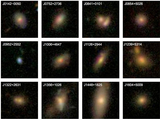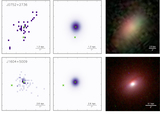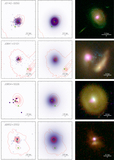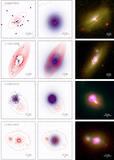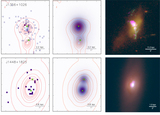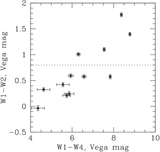Image Details
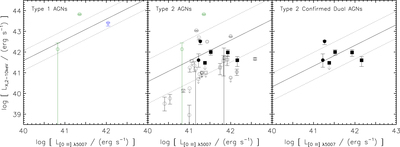
Caption: Figure 5.
Observed hard X-ray luminosity (2–10 kev) vs. observed [O III] λ5007 luminosity for confirmed dual AGNs (filled symbols), dual/offset AGNs (double symbols), and the likely single AGNs (open symbols). Left: a Type 1 AGN (blue circle) and two AGNs that could be Type 1 or Type 2 (green circles; Section 4.2.3). The observed relation for optically selected Type 1 single AGNs, log(﹩{L}_{X,2-10\;\mathrm{keV}}/{L}_{[{\rm O}\;{\rm III}]\lambda 5007})=1.59\pm 0.48﹩ (Heckman et al. 2005), is shown as the solid line, and the dotted lines illustrate the rms scatter. The Type 1 AGN that is part of a dual /offset AGN system falls below this relation but within the errors. Middle: Type 2 AGNs (black circles) and Type 1 or 2 AGNs (green circles; Section 4.2.3) from this paper, and Type 2 AGNs from observations of SDSS double-peaked AGNs from Comerford et al. (2011) and Liu et al. (2013, black squares). The observed relation for optically selected Type 2 single AGNs, log(﹩{L}_{X,2-10\;\mathrm{keV}}/{L}_{[{\rm O}\;{\rm III}]\lambda 5007})=0.57\pm 1.06﹩ (Heckman et al. 2005), is shown as the solid line, and the dotted lines illustrate the rms scatter. The Type 2 AGNs in our sample fall systematically below this relation. Right: confirmed dual AGNs that are Type 2 AGNs. We find that these confirmed dual AGNs are fit by log(﹩{L}_{X,2-10\mathrm{keV}}/{L}_{[{\rm O}\;{\rm III}]\lambda 5007})=0.32\pm 0.66﹩, which is shown by the solid line. The dotted lines illustrate the rms scatter.
Copyright and Terms & Conditions
© 2015. The American Astronomical Society. All rights reserved.


